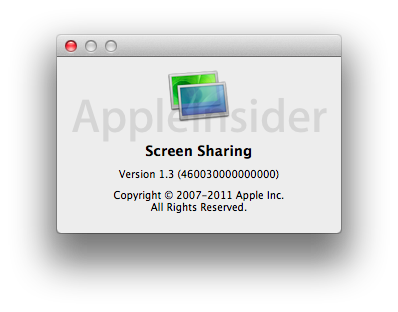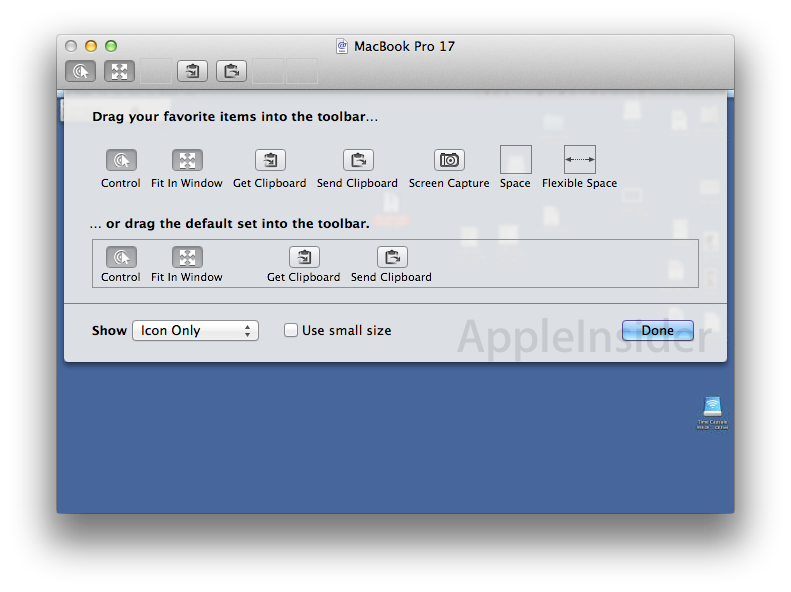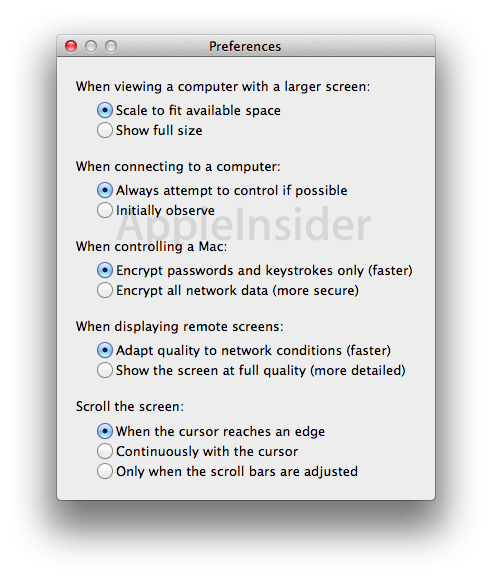Mac OS X 10.7 Lion to introduce multi-user Screen Sharing
In Mac OS X 10.3 Panther, Apple added Fast Users Switching to enable the system to support multiple users to be logged into their own graphical environment concurrently. Prior to that, each user had to log out before another could login to the graphical console. Multiple users could login via SSH, but only with a command line environment.
In Mac OS X 10.5 Leopard, Apple added Screen Sharing, a VNC client and server that enabled a user on one system to authenticate and view the screen of another system.
Since 2002, Apple had also separately sold Apple Remote Desktop, which allows for remote administration and management. In 2004, ARD switched to VNC, an open protocol that enabled the tool to remotely control not just Macs, but also Windows PCs and other Unix systems with a VNC server installed.
In Mac OS X 10.7 Lion, the built-in Screen Sharing feature, updated from 1.1.1 to version 1.3, now allows remote users to log into a separate user account from the one that is currently logged in. That means that while one user is logged into a machine, a second user can login to the same machine remotely, seeing their own desktop and user environment.
Previously, any users who attempted screen sharing with another system could only see a mirror of what was currently on the screen, and would "fight" for mouse and keyboard control of the remote system with that locally logged in user. Now, any user with the credentials to perform screen sharing can log into a Lion system independently of another user who may already be logged in, and continue to work in a separate graphical session parallel to the logged in user.
After logging in behind a local user on a Lion machine, the remote session depicted both users as being logged in from the Fast User Switching menu. The Lion system only indicated the local user was logged in. However, when the local Lion user attempted to switch users and login as the other user from the Fast User Switching menu, the system experienced a kernel panic, indicating that the feature is still a work in progress and that the new feature likely involves significant changes to how the system handles user logins.
Mac Terminal Services
This new functionality means Mac OS X Lion is now capable of multiple, concurrent graphical shells for remote users, similar to the technology Citrix created for Microsoft's Windows NT 3.51 to allow multiple remote users and login sessions.
Microsoft subsequently forced Citrix to license its software (in exchange for permission to sell its own product on NT 4) for Microsoft to adapt and sell as "Terminal Server," which later became Remote Desktop Connection. Unlike the plain vanilla VNC, Microsoft's proprietary RDC hooks into the core OS, usually allowing for better performance, particularly over slow network connections.
Microsoft implemented Fast User Switching on Windows XP using Terminal Services. It appears Apple is implementing its own "terminal services" in Lion as an extension of Fast User Switching.
In Lion, Apple has improved its Screen Sharing client app with Observe (view only) and Control modes and a Screen Capture button that all appear to be borrowed from Apple Remote Desktop. There are also additional new preferences available, including a keyboard shortcut for moving between remote Control and Observe modes.
An IT manager noted to AppleInsider that Lion does not appear to be compatible with the existing build of Apple Remote Desktop, although it can be reached with the Screen Sharing VNC client built into Mac OS X 10.6 Snow Leopard.
 AppleInsider Staff
AppleInsider Staff













 Mike Wuerthele
Mike Wuerthele
 Malcolm Owen
Malcolm Owen
 Chip Loder
Chip Loder

 William Gallagher
William Gallagher
 Christine McKee
Christine McKee
 Michael Stroup
Michael Stroup
 William Gallagher and Mike Wuerthele
William Gallagher and Mike Wuerthele







